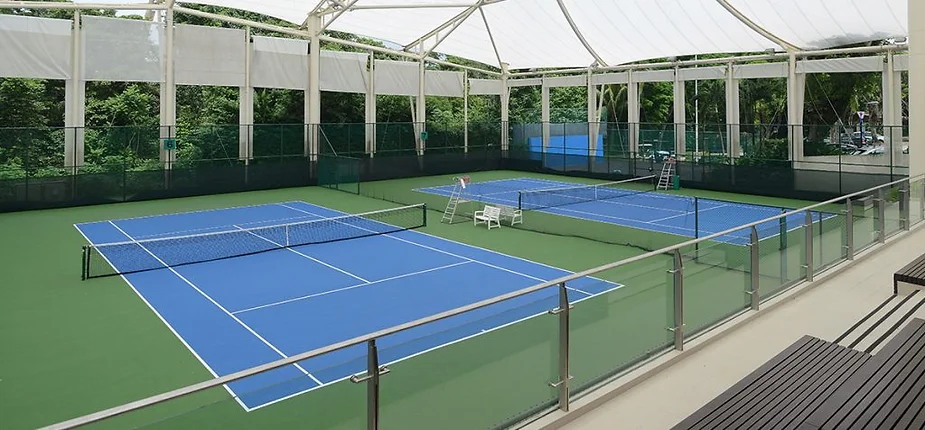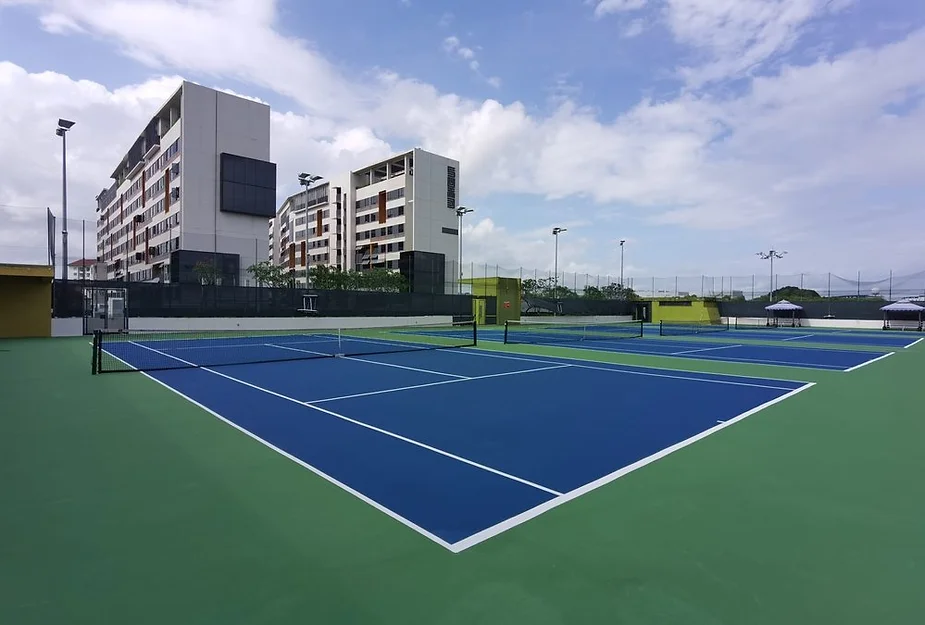Introduction
The sport of tennis has captivated athletes and fans for centuries, with its unique blend of skill, strategy, and athleticism. At the heart of this dynamic game lies the tennis court itself, a carefully designed space that sets the stage for exhilarating matches. Understanding the dimensions and specifications of a tennis court is essential for both players and spectators alike.
From the size of the court to the court measurements, every aspect contributes to the flow and fairness of the game. Additionally, the type of court surface used can greatly impact the style of play. Join us as we explore the intricacies of tennis court size, dimensions, and layout to gain a deeper appreciation for the sport.
Regulation Tennis Court Size
Regulation tennis court dimensions are no exception! The standard size for a singles match is 23.77m long by 8.23m wide, with the doubles match following suit at 26.97m x 11.9m respectively.
Although these measurements may seem arbitrary on the surface, there is actually quite a bit of strategy involved. Designed to provide an optimum playing field in terms of both fairness and excitement, these court sizes challenge players to utilize their agility and athleticism to the fullest. Tennis players must also be cognizant of the fact that each court will require a different approach, forcing them to develop a new tactical blueprint if they wish to come out on top.
With its unique combination of style and substance, regulation tennis court dimensions jumpstart any match into action! So go ahead – stretch your legs, swoosh your racket through the air, and enjoy the game.
Tennis Court Dimensions & Layout
For centuries, the dimensions and layout of tennis courts have been carefully crafted to create a classic playing field. Whether you’re in a professional tournament or your own backyard, it’s important to understand the structure of the court before you serve up your first shot.
At its heart is the 78-foot-long rectangular court, divided lengthwise into two equal halves by the center line; each half is 39 feet. At both ends of the court lies the baselines, stretching 36 feet for singles matches, and 27 feet for doubles play. The service line, which determines the distance from which you serve the ball, is 21 feet away from the net. Finally, three feet back from the net you will find the nine-foot-long doubles alley, which runs parallel to the sidelines.
These are all essential components of any tennis court – creating an arena with just enough space to test your skills against your opponent! From fast-paced volleys at the net to precision serves across the court, the layout of a tennis court ensures that this classic game remains as thought-provoking and enjoyable as ever.

What are the Dimensions of a Tennis Court in Feet? Are all Tennis Courts the Same Size?
Tennis courts come in a variety of sizes, but they all have one thing in common—they’re longer than they are wide. The dimensions of a standard tennis court are 78 feet long, and 27 feet wide, with a net running across the middle that is 3 feet high. Additionally, there are two service boxes on each side of the court that measure 21 feet across and 13.5 feet deep.
Tennis courts can range in size from these official dimensions to much smaller sizes depending on the types of competitions and the location. All regulation-size tennis courts must adhere to the same dimensions outlined by the United States Tennis Association. But this does not mean that courts cannot vary in other ways — surface type, line markings, and net height can all differ from court to court! Ultimately, the size of a tennis court will depend on its purpose and environment.
Does Overhead Space For Indoor Courts Matter?
As athletes, we understand the need for ample space to practice and compete. But do we really take into consideration the importance of having an adequate amount of overhead space for indoor courts? It’s easy to get caught up in the excitement of installing a new court but often overlook this important factor.
Having more overhead space provides athletes with greater opportunities for physical exercise, strategy execution, and creativity that simply can’t be created in smaller areas. The combination of added space and improved energy creates an enhanced competitive environment which encourages higher levels of play. Not only does additional overhead space lead to improved performance, it also provides better safety conditions for participants. Higher ceilings provide a buffer against potential damage from high-flying balls or players.
The importance of overhead space is something that most don’t think about until they’re on the court. When you’re looking for the perfect court, make sure to factor in the optimal overhead space so that all your participants can benefit from its positive effects.
Space Needed to Build a Court
Building a court isn’t just a matter of waving a magic wand, it requires thoughtful planning and consideration of the available real estate. Do you have the necessary 80 feet by 50 feet needed for the full scale size of regulation basketball court? That’s enough space to fit all your friends on the court and provide ample room for player movement.
That’s why it pays to do your research when it comes to building a tennis court. Get creative with your options – is there a nearby park or public space that could serve as your playground? Or are there alternative measures that could make the process simpler? A hoop in your backyard could be the perfect place to practice those layups.
At the end of the day your court building dreams depend on the space you can access. So look around -your perfect basketball court might have been right under your nose all along.

Types of Tennis Courts – Grass, Clay and Hard
Tennis courts come in a variety of textures and surfaces, each offering players a unique experience.
Grass is the original surface used on lawn tennis courts. It’s naturally springy and provides an added level of bounce for players to take advantage of. Although grass requires regular maintenance, there’s nothing quite like playing on a bouncy, lush green surface.
Clay courts are made from finely ground rock and brick dust mixed with water. The soft material provides excellent grip to help maneuver your shots effectively while also slowing down the ball just enough to provide an extra second of reaction time. The main downside is that clay can sometimes be slippery if not kept well-maintained.
Hard courts are usually composed of both asphalt and concrete. This consistent yet slightly softer surface allows for easy movement across the court – perfect for beginners looking to pick up the game quickly! Plus, hard courts tend to produce faster rallies due to the low traction, making them great for competitive matches.
No matter what type of court you play on, you’re sure to have a unique experience every time you step onto it.
Conclusion
In conclusion, understanding the dimensions and layout of a tennis court is crucial for both players and spectators. The overall court length is 78 feet, with a width of 36 feet for doubles matches and 27 feet for singles matches. The components of a complete court include the net, baseline, service line, and alleys. The side boundaries of the court consist of the singles sideline and the doubles sideline, spanning the entire length of the court. Additionally, different court surfaces, such as grass, clay, and hard court, can greatly affect the gameplay and player’s strategies. Overall, having knowledge about the dimensions and layout of a tennis court enhances the understanding and enjoyment of the sport.






One Response